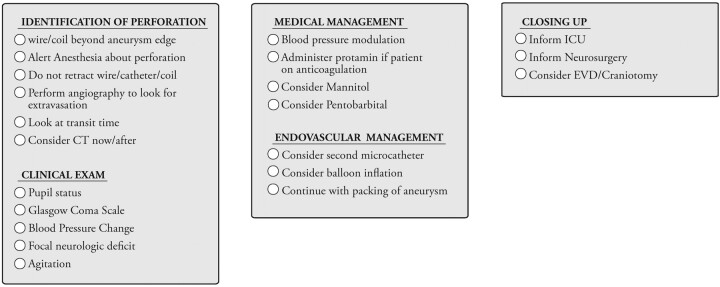The use of checklists is well-established in aviation, where their application is an integral part of every sequence of flying.1 In cases of emergency flying procedures, the use of checklists is fundamental in dealing with critical tasks, and their application is a central part of pilot training and pilot performance.2
Checklists have only recently been introduced in medicine in an effort to manage a number of procedures in a uniform manner, according to the established standard of care.3 While suited especially for complex or emergency tasks, the application of a checklist in reducing morbidity and mortality for the placement of a central line has gained wide recognition.4–7
Recently, Atul Gawande, a surgeon at Harvard Medical School, has published his experience with checklists in medicine, aviation, and building construction, in his book The Checklist Manifesto: How to Get Things Right.8 The book details his experience in developing a checklist for the World Health Organization in its global effort to reduce the morbidity and mortality of surgical interventions. The checklist incorporated 19 simple items, ranging from the identification of the correct patient and correct surgical site to confirming the application of preoperative antibiotics and making sure all team members in the operating room know each other and their respective roles.8,9 Their initial results, published in the New England Journal of Medicine in 2009, showed dramatic results in reducing both morbidity and mortality at the pilot study sites.9
This effort has led us to believe that checklists have the potential of becoming significant tools in making medicine, and more specifically interventions, safer.3 From a neurointerventional point of view, it was the belief the authors, comprising both neurointerventionalists (G.L., H.C., D.K.) and neurosurgeons (Ph.T., G.L.), that the perforation of aneurysms during coiling is one of the most critical events in the neurointerventional field. The correct response in these instances is guided not only by experience but also by taking the correct measures, with a large number of steps involving clinical, interventional, anesthesiologic, and organizational aspects. As a result, a checklist may help both the experienced and less experienced practitioner to react in the event of aneurysmal rupture according to the best standard of care.10
The checklist (Fig 1) proposed here is an initial effort to translate the personal and published experience of both neurosurgeons and neuroradiologists regarding the handling of an aneurysmal perforation during coiling according to the best standard of care. At the heart of this effort is the inspiration of Atul Gawande's book, and we are eager to have the checklist used, studied, and improved.
Fig 1.
Checklist for aneurysm perforation during coiling. ICU indicates intensive care unit; EVD, external ventricular drain.
References
- 1. Degani A, Wiener EL. Procedures in complex systems: the airline cockpit. IEEE Trans Syst Man Cybern A Syst Hum 1997;27:302–12 [DOI] [PubMed] [Google Scholar]
- 2. Rantz WG, Dickinson AM, Sinclair GA, et al. The effect of feedback on the accuracy of checklist completion during instrument flight training. J Appl Behav Anal 2009;42:497–509 [DOI] [PMC free article] [PubMed] [Google Scholar]
- 3. Winters BD, Gurses AP, Lehmann H, et al. Clinical review: checklists—translating evidence into practice. Crit Care 2009;13:210. Epub 2009 Dec 31 [DOI] [PMC free article] [PubMed] [Google Scholar]
- 4. Pronovost PJ, Goeschel CA, Colantuoni E, et al. Sustaining reductions in catheter-related bloodstream infections in Michigan intensive care units: observational study. BMJ 2010;340:c309. [DOI] [PMC free article] [PubMed] [Google Scholar]
- 5. Watson SR, George C, Martin M, et al. Preventing central line-associated bloodstream infections and improving safety culture: a statewide experience. Jt Comm J Qual Patient Saf 2009;35:593–97 [DOI] [PubMed] [Google Scholar]
- 6. Hales BM, Pronovost PJ. The checklist: a tool for error management and performance improvement. J Crit Care 2006;21:231–5 [DOI] [PubMed] [Google Scholar]
- 7. Berenholtz SM, Pronovost PJ, Lipsett PA, et al. Eliminating catheter-related bloodstream infections in the intensive care unit. Crit Care Med 2004;32:2014–20 [DOI] [PubMed] [Google Scholar]
- 8. Gawande A. The Checklist Manifesto: How to Get Things Right. New York: Metropolitan Books; 2009 [Google Scholar]
- 9. Haynes AB, Weiser TG, Berry WR, et al. , for the Safe Surgery Saves Lives Study Group. A surgical safety checklist to reduce morbidity and mortality in a global population. N Engl J Med 2009;360:491–99. Epub 2009 Jan 14 [DOI] [PubMed] [Google Scholar]
- 10. Doerfler A, Wanke I, Egelhof T, et al. Aneurysmal rupture during embolization with Guglielmi detachable coils: causes, management, and outcome. AJNR Am J Neuroradiol 2001;22:1825–32 [PMC free article] [PubMed] [Google Scholar]



